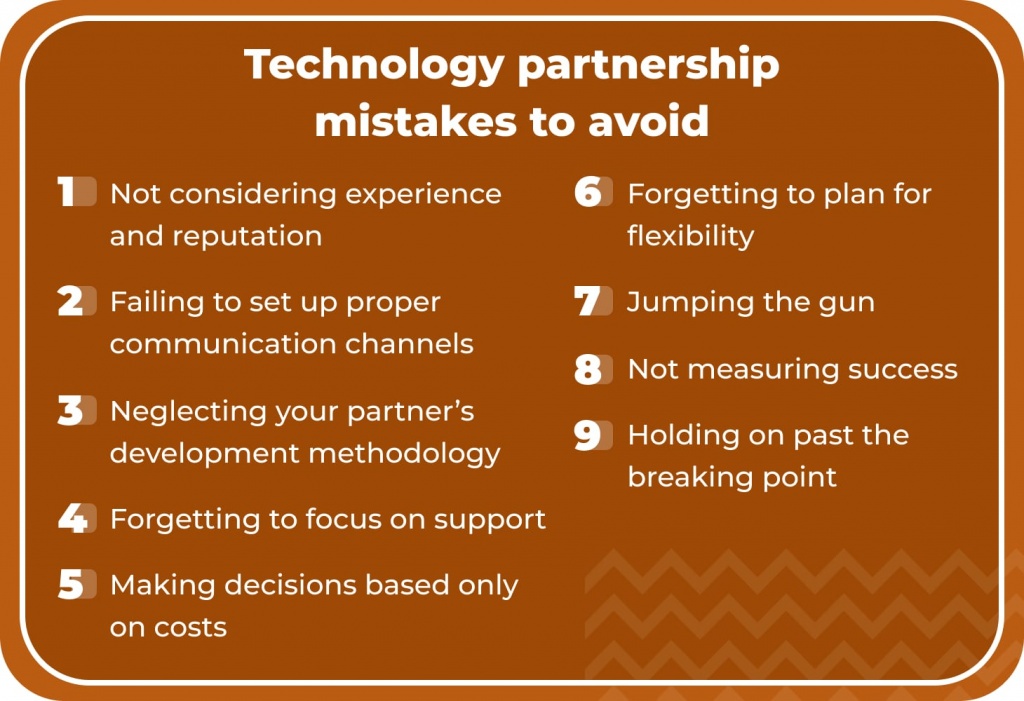Partnering with a tech company can be an excellent way to expand your offering and drive growth. It allows you to create digital products and services that meet customer pain points, without investing in additional resources, moving away from your core value proposition, or making critical mistakes. Partnerships can help you add new lines of revenue, pushing up customer loyalty and boosting your profits.
However, there’s a right way and a wrong way to go about technology partnerships. As tech experts who specialize in partnerships, we’ve heard plenty of horror stories about mistakes that companies make when they enter a technology partnership.
In this blog, we’ve drawn on our experiences to share the 9 main ways that people mess up technology partnerships, and what you can do to avoid getting caught out.

1. Not considering experience and reputation
It’s easy to get distracted by impressive websites and powerful pitches, but it’s also risky. You could end up with a company that can’t or won’t meet your needs, leaving you with unreliable customer service, disappointed clients, and/or a failed project.
Instead, look for experienced partners with a proven track record of successful projects. Research potential partners thoroughly by asking for case studies, speaking to client references, investigating their portfolios, and checking industry reviews.
Ideally, find a partner that has experience in your specific project type, audience, and/or industry. They understand your challenges, are already familiar with relevant regulations, and speak your language, all of which help smooth the path to a positive and profitable outcome.
2. Failing to set up proper communication channels
A partnership is a relationship, and like all relationships, communication is crucial for success. Unless your tech partner fully understands your needs, you’ll receive ineffective solutions and lackluster support, so inefficient communication channels can handicap you with misunderstandings, unresolved issues, and project delays.
To avoid this mistake, establish specific communication channels like email, Slack, or phone calls; agree on how frequently you’ll check in; and designate contact people who’ll be responsible for keeping everyone on the same page. What matters is that you update each other about progress, you’re open about issues that arise, and you share feedback promptly, so that both sides are aligned and you can resolve problems as quickly as possible.
3. Neglecting your partner’s development methodology
You might think that it doesn’t matter how your partner develops tech products. But you’d be wrong. Development methodology affects how the project is managed, how changes are handled, and how progress is communicated. In the long run, a methodology mismatch can result in misaligned expectations, inefficient workflows, and project delays.
Explore your potential partner’s methodology before the project. Find out whether they use Agile, Scrum, or another approach, and ask detailed questions about QA processes and how they handle changes in project scope. Make sure your partner’s methodology supports transparency, flexibility, and steady progress towards project goals.
4. Forgetting to focus on support
Building your new tech offering is only the beginning. You also need to drive sales, educate your team and your audience, and ensure that your tech remains relevant, user-friendly, and bug-free. Unless you work with a tech partner who can deliver effective support, you’ll risk neglected software, security vulnerabilities, unmet business needs, and frustrated customers.
When you evaluate potential partners, investigate their ability and experience in providing long-term support for sales, marketing, customer service, and technical fixes. Ask them about their policies on maintenance, updates, and bug fixes, find out what content and tools they provide for sales and marketing, and write Service Level Agreements (SLAs) for issue resolution into your contract.
5. Making decisions based only on costs
Cost is a serious factor, but it shouldn’t override alignment on culture, goals, and business vision. Allowing costs to lead your technology partnership decision-making can result in a poor relationship with partners that don’t share your priorities, deliver poor-quality products, and/or create friction within your workforce.
Instead, consider how well this partner’s skills align with your requirements, and whether they can work with you to resolve issues. Check their average turnover rate and talk to long-serving employees to assess their work culture and establish that they can work smoothly alongside you. Remember, a tech partnership is also a strategic partnership and should be a long-term relationship.
6. Forgetting to plan for flexibility
In an ideal world, everything will go according to plan. But your tech project isn’t taking place in an ideal world, and pretending it does risks unpleasant surprises and unsatisfactory outcomes. Tech is constantly changing, so if you nail your projects down to a rigid definition, they’re likely to be out of date soon after they launch, if not before.
Unlike waterfall projects, where each phase of the project is clearly defined and dependent on the one before it, tech projects do best when they’re allowed to evolve according to a broad goal. Budget for scope creep (uncontrolled growth), embrace agile project management, and engage in flexible planning that allows you to adapt to new circumstances and carry out iterative improvements for a successful tech solution.
7. Jumping the gun
Of course you’re excited to begin your tech project, but don’t rush in. If you move too fast, you could find yourself building solutions on an unstable foundation, leading to inefficiencies, increased costs, and potential project failures. If you don’t properly assess and prepare the landscape, you might overlook critical issues that can hinder future growth and scalability.
Start small and expand gradually. Take the time to thoroughly evaluate your current technology, digital platforms, data, and overall approach, together with your tech partner, so you can lay robust foundations. These provide a stable base for future developments, leading to more effective and sustainable growth.
8. Not measuring success
The saying “if you don’t measure it, you can’t manage it” is already set in stone. Without clear metrics, you can’t evaluate the success of your project or identify areas for improvement. This leaves you unable to gauge progress, justify costs, or make informed decisions about future projects.
Establish clear, measurable goals and success criteria from the outset. Set KPIs that are aligned with your business objectives, and regularly track and analyze them to ensure that your project and your tech partner are delivering value. Then you can decide what adjustments to make to achieve desired outcomes.
9. Holding on past the breaking point
Nobody likes to admit failure, but denying that a partnership isn’t working only results in greater losses. If you continue a failing relationship, you’ll just pour money, time, and effort into a dead end. You’ll waste resources, miss opportunities, and exacerbate frustration all around.
Instead, keep a clear eye on your performance metrics and regularly assess your partnership against your milestones and goals. If it’s consistently falling short and issues are going unresolved despite your best efforts, it’s time to move on. When you have an exit strategy and recognize when to cut your losses, you can redirect your energy to finding a more suitable partner.
A successful tech partnership requires a clear vision
If you’re feeling a little nervous about entering a tech partnership now, let us reassure you. Forewarned is forearmed. Once you’re aware of the mistakes that can hold partnerships back from success, you’ll be able to avoid committing them and be able to set up a successful and long-lasting partnership program.



























